最新100个发音秘诀
汉字读音速记口诀大全
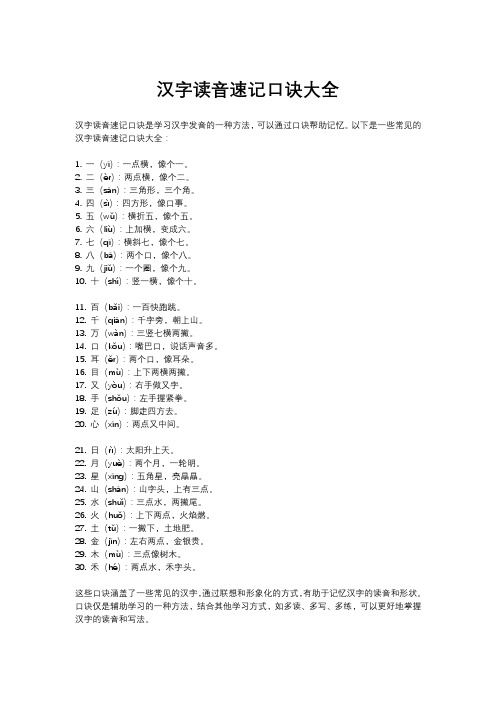
汉字读音速记口诀大全汉字读音速记口诀是学习汉字发音的一种方法,可以通过口诀帮助记忆。
以下是一些常见的汉字读音速记口诀大全:1. 一(yī):一点横,像个一。
2. 二(èr):两点横,像个二。
3. 三(sān):三角形,三个角。
4. 四(sì):四方形,像口事。
5. 五(wǔ):横折五,像个五。
6. 六(liù):上加横,变成六。
7. 七(qī):横斜七,像个七。
8. 八(bā):两个口,像个八。
9. 九(jiǔ):一个圈,像个九。
10. 十(shí):竖一横,像个十。
11. 百(bǎi):一百快跑跳。
12. 千(qiān):千字旁,朝上山。
13. 万(wàn):三竖七横两撇。
14. 口(kǒu):嘴巴口,说话声音多。
15. 耳(ěr):两个口,像耳朵。
16. 目(mù):上下两横两撇。
17. 又(yòu):右手做又字。
18. 手(shǒu):左手握紧拳。
19. 足(zú):脚走四方去。
20. 心(xīn):两点又中间。
21. 日(rì):太阳升上天。
22. 月(yuè):两个月,一轮明。
23. 星(xīng):五角星,亮晶晶。
24. 山(shān):山字头,上有三点。
25. 水(shuǐ):三点水,两撇尾。
26. 火(huǒ):上下两点,火焰燃。
27. 土(tǔ):一撇下,土地肥。
28. 金(jīn):左右两点,金银贵。
29. 木(mù):三点像树木。
30. 禾(hé):两点水,禾字头。
这些口诀涵盖了一些常见的汉字,通过联想和形象化的方式,有助于记忆汉字的读音和形状。
口诀仅是辅助学习的一种方法,结合其他学习方式,如多读、多写、多练,可以更好地掌握汉字的读音和写法。
纯正发音的100个秘诀
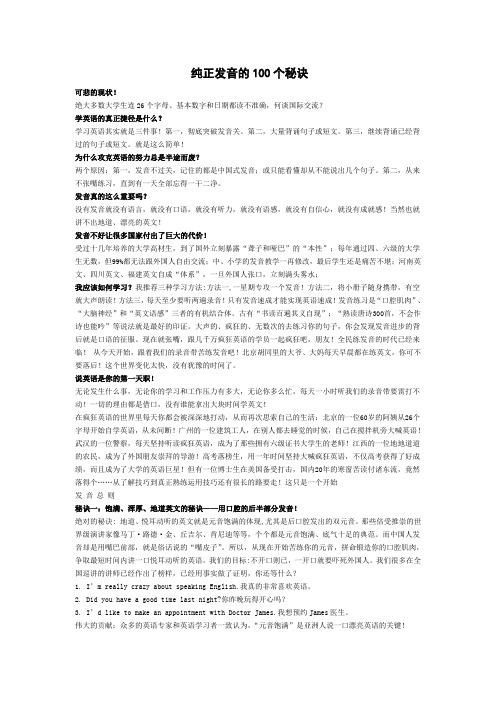
纯正发音的100个秘诀可悲的现状!绝大多数大学生连26个字母、基本数字和日期都读不准确,何谈国际交流?学英语的真正捷径是什么?学习英语其实就是三件事!第一,彻底突破发音关。
第二,大量背诵句子或短文。
第三,继续背诵已经背过的句子或短文。
就是这么简单!为什么攻克英语的努力总是半途而废?两个原因:第一,发音不过关,记住的都是中国式发音;或只能看懂却从不能说出几个句子。
第二,从来不张嘴练习,直到有一天全部忘得一干二净。
发音真的这么重要吗?没有发音就没有语言,就没有口语,就没有听力,就没有语感,就没有自信心,就没有成就感!当然也就讲不出地道、漂亮的英文!发音不好让很多国家付出了巨大的代价!受过十几年培养的大学高材生,到了国外立刻暴露“聋子和哑巴”的“本性”;每年通过四、六级的大学生无数,但99%都无法跟外国人自由交流;中、小学的发音教学一再修改,最后学生还是痛苦不堪;河南英文、四川英文、福建英文自成“体系”,一旦外国人张口,立刻满头雾水;我应该如何学习?我推荐三种学习方法:方法一,一星期专攻一个发音!方法二,将小册子随身携带,有空就大声朗读!方法三,每天至少要听两遍录音!只有发音速成才能实现英语速成!发音练习是“口腔肌肉”、“大脑神经”和“英文语感”三者的有机结合体。
古有“书读百遍其义自现”;“熟读唐诗300首,不会作诗也能吟”等说法就是最好的印证。
大声的、疯狂的、无数次的去练习你的句子,你会发现发音进步的背后就是口语的征服。
现在就张嘴,跟几千万疯狂英语的学员一起疯狂吧,朋友!全民练发音的时代已经来临!从今天开始,跟着我们的录音带苦练发音吧!北京胡同里的大爷、大妈每天早晨都在练英文,你可不要落后!这个世界变化太快,没有犹豫的时间了。
说英语是你的第一天职!无论发生什么事,无论你的学习和工作压力有多大,无论你多么忙,每天一小时听我们的录音带要雷打不动!一切的理由都是借口,没有谁能拿出大块时间学英文!在疯狂英语的世界里每天你都会被深深地打动,从而再次思索自己的生活:北京的一位60岁的阿姨从26个字母开始自学英语,从未间断!广州的一位建筑工人,在别人都去睡觉的时候,自己在搅拌机旁大喊英语!武汉的一位警察,每天坚持听读疯狂英语,成为了那些拥有六级证书大学生的老师!江西的一位地地道道的农民,成为了外国朋友崇拜的导游!高考落榜生,用一年时间坚持大喊疯狂英语,不仅高考获得了好成绩,而且成为了大学的英语巨星!但有一位博士生在美国备受打击,国内20年的寒窗苦读付诸东流,竟然落得个……从了解技巧到真正熟练运用技巧还有很长的路要走!这只是一个开始发音总则秘诀一:饱满、浑厚、地道英文的秘诀——用口腔的后半部分发音!绝对的秘诀:地道、悦耳动听的英文就是元音饱满的体现,尤其是后口腔发出的双元音。
英语100发音秘诀

密诀1 最坚实的基础--疯狂突破字母关这是一首优美、现代的字母歌,绝对不是我们从小就熟悉的那首“比较弱智”的字母歌!请一定要反复听、反复模仿。
26个字母、26个单词、26个句子,疯狂模仿,发音必会产生飞跃!A的读音为IPA: [ei]I'm afraid you've made a mistake.K.K: [e]恐怕您搞错了。
B的读音为IPA: [bi:]I won't be able to finish my work.K.K: [bi]我不能完成工作了。
C的读音为IPA: [si:]I don't see what you mean.K.K: [si]我不懂你的意思。
D的读音为IPA: [di:]I've heard a great deal about you.K.K: [di]久仰大名。
E的读音为IPA: [i:]He is easy to deal with.K.K: [i]他很容易打交道。
F的读音为IPA: [ef]Will you sit on my left?K.K: [ f ]你坐在我左边好吗?G的读音为IPA: [ ]Lets of students wear jeans nowadays.K.K: [ ]现在很多学生穿牛仔裤。
H的读音为IPA: [ ]Let me have a look at the book.K.K: [ ]让我看一看这本书。
I的读音为IPA: [ ]I could , and I should, but I wouldn't do it.K.K: [ ]这个我能做,我也应该做,但是我不愿意做。
J的读音为IPA: [ ]He was jailed for two years.K.K: [ ] 他被囚禁了两年。
K的读音为IPA: [ ]In any case, it's none of your business.K.K: [ ]无论如何,那事与你无关。
纯正美语发音100个秘诀(李阳)

纯正美语发音100个秘诀史上最牛英语口语学习法:躺在家里练口语,全程外教一对一,三个月畅谈无阻!太平洋在线英语,可免费体验全部外教一对一课程:第一章字母发音突破秘诀1最坚实的基础——疯狂突破字母关这是一首优美、现代的字母歌,绝对不是我们从小就熟悉的那首“比较弱智”的字母歌!请一定要反复听、反复模仿。
Are you ready to learn your ABCs?A is for the airplane,above the clouds so high,sowing and sing,like a big bird in sky.B is for a bunny,but it doesn't cut his tail,he goes cipety hup hup hup,a longer bunny trail.C is for my cat,she is as cuddly as can be, but she meanout so lovely that she gets stark out been a tree.D is for the daytime,when the sun is shining bright,that's the time i go to school,and learn to dothings right.E is for an elephant,he is big and has no hands,but he can use his long long chark to meet all his demands.F is for the fire engine,there is a fire off a head,when in the car put orberin start,and let it go instead.G is for a little girl,the upside is a boy,it's fun to play together,and they can share their toys.H is for hello,which is something nice to see,it means i'm glad to see you,any time of day.I is for an inside,like butterflies in beens,they are all a part of nature,so protect them if you please.J is for your jacket,when you go outside you wear it,it keeps you nice and warm,so you can play without care.K is for a kite,you can fly it in the wind,sometimes riving low,but damn it she start got again.L is for the leaves,that they are green and grow on trees,sometimes they turn colors and fall to groud a piece.M is for music,there is music in this song,and if you learn the words to it,and you can sing along.N is for your nose,it's in the middle of your face,and with your nose you can smell the cookies around just a bit.O is for an orange like holding sunshine in your hands,iplan owen obnin,and then give some to your friends.P is for your puppy,that's a dog very small,when he gets older, just like you,he will be strong and tall.Q is for quiet,it's the opposite of live,it's hard when there are so many sounds,and when you're in a crowd.R is for the rain,water falling from the sky,it's hard to not get wet,but if you want to you can try.S is for a song,like the one i'm singing to you,it can make you happy and can help you learn things too.T is for a teacher,at school or anywhere,they show you how to learn a lot like B and right we care.U is for umbrella,you can use it when it rains,keep you nice and dry,tip a sentence that again.V is for a visit,and we can sometimes go,to grandma's or to aunt's or to other friends you know.W is a welcome,that's what i like say,when friends come to my house it means come on in and play.X is for a xenophon,it's an instrument you know,or you can use an X when you play take-tatoo.Y is for you,that's the person that you are,to me and all your friends,and we hope that you go far.Z is for zoo,lots of animals to see,and everyone is very special,just like you and me.And now you learn your ABCs,have fun, good这是一首优美、现代的字母歌,绝对不是我们从小就熟悉的那首“比较弱智”的字母歌!请一定要反复听、反复模仿。
学唱歌必备的发声要领口诀

学唱歌必备的发声要领口诀在无数的演唱实践中总结出来的,这几个口诀概括了唱歌发声技巧的所有内容,下面这些是小编为大家推荐的学唱歌必备的发声要领口诀相关资料。
学唱歌必备的发声要领口诀一、歌唱姿势要领口诀头正、颈直、看前方,“脊梁插着擀面杖”。
自然挺胸双肩垂,张嘴下巴“懒洋洋”。
双腿站立前后分,重心放在前脚上。
手势自然形体美,“松而不懈”“紧不僵”。
收腹提臀两胯开,积极、松弛全身唱。
二、歌唱呼吸要领口诀鼓腹吸气沉“丹田”,贴着咽壁“吸着唱”。
胸口松开向下“叹”,气沉胸底腰扩张。
“又吸又呼”声流动,气向下“铺”音向上。
腰一缓劲儿就换气,被动换气不用想。
“关闭”高音气倒灌,腔体松开“一米长”。
“气行于背”“吹瓶口”,“吹”响头腔点明亮。
后背控制上、下“吸”,全身舒展气流畅。
呼吸稳定最省力,轻松愉快把歌唱。
三、歌唱发音要领口诀胸口发音不能憋,“声音落底”气通畅。
“声门适度”“三不准”①,腔体上下要“虚张”。
张嘴“内视”往下“看”,喉结下沉底宽敞。
“忘掉喉头”没感觉,“听着、看着”咽腔响。
胸口往下找气柱,音色纯净又明亮。
“高音气大嗓眼儿小”,声带不躲要敢唱。
气混声儿来声混气,贴边儿向后进咽腔。
四、歌唱共鸣要领口诀共鸣位置在咽壁,共鸣音响灌咽腔。
共鸣反射找“焦点”,前“哈”后“哼”气通畅②。
音域升高变母音,腔体“打开”要舒张。
“关闭”拢住共鸣点,声音胀满鼻咽腔。
抬起软腭“打哈欠”,“打开喉咙”气通畅。
五、歌唱语言要领口诀“贴着咽壁吸着念”,咬字吐词在咽腔。
“挂住字头”往后送,胸口换字不能忘。
被动念字最轻松,语音清晰声音棒。
“挂住前面往后兜”,高音“说”、唱在头腔。
言语生动情感深,音色、力度巧变样。
传情达意需准确,语气“喷口”要恰当。
“字正腔圆”真功夫,表现内容有分量。
“声情并茂”才感人,歌唱艺术魅力强。
① 声带上“不准挂音,不准用劲儿,不准通气儿”是感觉上的三不准。
② 前“哈”后“哼”的意思为:声音向前反射时,有哈气的感觉,声音向后哼唱时,有往后*的感觉,所以是气向前声儿向后的感觉。
国际发音48个正确发音方法

国际发音48个正确发音方法一。
说起国际发音的 48 个正确发音方法,那可是打开流利英语大门的金钥匙!这 48 个音,就像是 48 个小精灵,每个都有自己独特的脾气和特点。
1.1 元音。
元音那可是发音中的大主角,像“a”“e”“i”“o”“u”这些,发音要饱满、圆润。
比如说“a”,就像嘴里含了个大苹果,嘴巴张得大大的。
再比如“i”,发音的时候嘴巴咧得像在微笑。
1.2 辅音。
辅音呢,就像是元音的好搭档。
像“b”“p”“m”这些,发音要清晰有力。
“b”发音时,双唇紧闭,然后猛地放开,“p”也是一样,不过气流更强,要有那种“爆破”的感觉。
二。
2.1 长元音和短元音。
这可得好好区分。
长元音要拖长声音,短元音则要短促有力。
比如说“ee”和“i”,“ee”读起来就像拉长了的“i”。
2.2 双元音。
双元音那可有趣啦,是两个元音的组合。
像“ai”“ei”,发音要从一个元音滑向另一个元音,要自然流畅,不能生硬。
2.3 清辅音和浊辅音。
清辅音和浊辅音就像是一对双胞胎,长得像,性格可不同。
清辅音发音时声带不振动,浊辅音则要振动声带。
比如“s”和“z”,仔细感受一下,是不是不一样?三。
3.1 发音的口型和舌位。
发音准不准,口型和舌位很关键。
有的音需要嘴巴张大,有的需要嘴唇收圆,舌头也要放在正确的位置。
这就像是跳舞,每个动作都要到位。
3.2 多听多模仿。
想要发音标准,得多听原声,模仿人家的发音。
就像学唱歌,跟着原唱才能找到感觉。
听英语广播、看英语电影,都是好办法。
掌握这 48 个正确发音方法,就像拥有了魔法,能让你的英语说得又好听又地道!只要用心去学,去练,一定能成功!。
音标发音规律记忆口诀
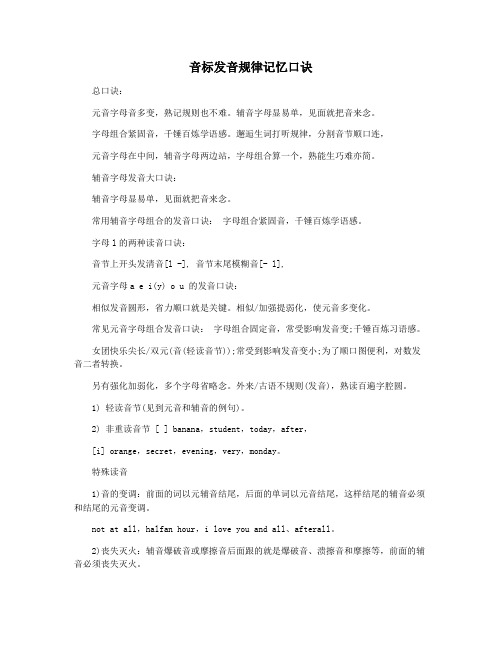
音标发音规律记忆口诀总口诀:元音字母音多变,熟记规则也不难。
辅音字母显易单,见面就把音来念。
字母组合紧固音,千锤百炼学语感。
邂逅生词打听规律,分割音节顺口连,元音字母在中间,辅音字母两边站,字母组合算一个,熟能生巧难亦简。
辅音字母发音大口诀:辅音字母显易单,见面就把音来念。
常用辅音字母组合的发音口诀:字母组合紧固音,千锤百炼学语感。
字母l的两种读音口诀:音节上开头发清音[l -], 音节末尾模糊音[- l],元音字母a e i(y) o u 的发音口诀:相似发音圆形,省力顺口就是关键。
相似/加强提弱化,使元音多变化。
常见元音字母组合发音口诀:字母组合固定音,常受影响发音变;千锤百炼习语感。
女团快乐尖长/双元(音(轻读音节));常受到影响发音变小;为了顺口图便利,对数发音二者转换。
另有强化加弱化,多个字母省略念。
外来/古语不规则(发音),熟读百遍字腔圆。
1) 轻读音节(见到元音和辅音的例句)。
2) 非重读音节 [ ] banana,student,today,after,[i] orange,secret,evening,very,monday。
特殊读音1)音的变调:前面的词以元辅音结尾,后面的单词以元音结尾,这样结尾的辅音必须和结尾的元音变调。
not at all,halfan hour,i love you and all、afterall。
2)丧失灭火:辅音爆破音或摩擦音后面跟的就是爆破音、溃擦音和摩擦等,前面的辅音必须丧失灭火。
good girl,goodstudent,good job,expression,school,extreme。
3)音的同化:两个特定的音遇到一起,可以收到变异成特定的音。
would you do it?i amglad to meet you、can't you see it?last year,this year。
重音a)双音节词a)一般在第一个音节重读。
汉语拼音发音口诀及方法

汉语拼音发音口诀及方法汉语拼音是拼写汉字的音节符号,它通过特定的发音规则来表示汉字的读音。
知道拼音的发音口诀和方法对于学习汉语拼音和发音非常重要。
下面是汉语拼音发音口诀及发音方法的详细介绍。
1.b、p、m、f:两边闭嘴唇,轻轻吹气。
2.d、t、n、l:稍微张开嘴巴,舌尖抵住上齿龈。
3.g、k、h:再大一点儿力气,用喉头发音。
4.j、q、x:舌头蜷缩,发音时往上顶。
5. zh、ch、sh:舌头平躺,声带不振动。
6.r:舌尖抵住上齿龈,舌面稍稍扁平。
7.z、c、s:张大嘴巴,尽量展示声音。
1.a:下巴微微抬。
2.o:嘴巴闭起来,发音时不要露齿。
3.e:口型稍微张开,嘴巴呈半圆形。
4. ai:嘴巴呈椭圆形。
5. ei:嘴巴稍稍闭合,嘴巴呈半圆形。
6. ao:嘴巴呈椭圆形,尾音略短。
7. ou:嘴巴稍稍闭合,发音时尾音稍长。
8. an:上下牙齿贴住,发出重音。
9. en:嘴巴呈折角形。
10. ang:嘴巴稍稍张开,发音时不要露齿。
11. eng:嘴巴呈折角形,尾音稍短。
12. ong:嘴巴稍稍抿起,舌头放下。
声调是汉语中表示意思的重要成分。
以下是每个声调的发音口诀和方法:1.一声:声调平平上去来。
发音时声调平平扬,发音词尾起上扬。
2.二声:声音强烈上一场。
发音时声调平平降,急促短促最显著。
3.三声:上声升,下声退。
声调时升时上扬,发音词尾有儿响。
4.四声:声高低,转折处。
下降后上升音,音调中间一下子提。
发音时注意声调变化,把握好每个音的强弱。
1.一声:平上去来!!例如:dā、bǎ。
2.二声:平上去来?例如:ér、néng。
3.三声:升上去?例如:sān、wǔ。
4.四声:升入去来!例如:gū、mèi。
发音时注意每个字的声调,把握好变调规律。
1. 拼读bpmf,懂得五大声。
例如:ba、pai、mian、fen。
2. 拼读dtln,百分之二成篇。
例如:de、tui、liang、nian。
纯正美语发音100个秘诀

秘诀26How about you?Take care that you don’t spoil your new clothes.A: I’m very glad to meet you.B: It’s a pleasure to meet you.I’m sorry to tell that you’ve been dismissed.秘诀27Could you tell me where the bus stop is?A: Did you panic?B: Of course! It was awful!Would you show me the bathroom, please?Would you care to go for a walk with me? (Care of 想)Could you do me a favor?Could you possibly give me a lift home? 你能让我搭个便车回家吗?秘诀28因发音部位的影响而发生的同化this shipHas she come?He tell you the truth.秘诀29Thank you.I take a walk along the river bank every morning.I think I can learn to speak good English in one month.Hunger is best sauce.He hungered for her love.I was angered by his refusal to come to the party.秘诀30He lives by his pen.All of his dealings are in the open.Let’s be open with each other.I want you to be open with me about your money problems, so I can help you. Do you happen to know his new telephone number?秘诀31]ΩρXνnorth [ ]νΛTρXν⎺northern []νΛTΘσ⎺] southern [ ΩυBσsouth []Ω*ωworth [ ]IT*ω⎺worthy [She has traveled in northern countries.The southern half of the country is a desert.She says help only the worthy poor.This book is worthy of being read [ to be read ].秘诀32spendHow do you spend you leisure? 你是怎样消磨空闲时间的。
英语音标48个发音口诀
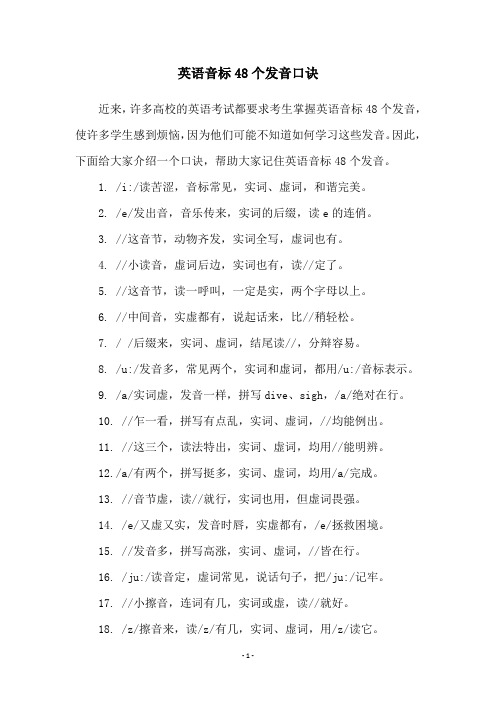
英语音标48个发音口诀近来,许多高校的英语考试都要求考生掌握英语音标48个发音,使许多学生感到烦恼,因为他们可能不知道如何学习这些发音。
因此,下面给大家介绍一个口诀,帮助大家记住英语音标48个发音。
1. /i:/读苦涩,音标常见,实词、虚词,和谐完美。
2. /e/发出音,音乐传来,实词的后缀,读e的连俏。
3. //这音节,动物齐发,实词全写,虚词也有。
4. //小读音,虚词后边,实词也有,读//定了。
5. //这音节,读一呼叫,一定是实,两个字母以上。
6. //中间音,实虚都有,说起话来,比//稍轻松。
7. / /后缀来,实词、虚词,结尾读//,分辩容易。
8. /u:/发音多,常见两个,实词和虚词,都用/u:/音标表示。
9. /a/实词虚,发音一样,拼写dive、sigh,/a/绝对在行。
10. //乍一看,拼写有点乱,实词、虚词,//均能例出。
11. //这三个,读法特出,实词、虚词,均用//能明辨。
12./a/有两个,拼写挺多,实词、虚词,均用/a/完成。
13. //音节虚,读//就行,实词也用,但虚词畏强。
14. /e/又虚又实,发音时唇,实虚都有,/e/拯救困境。
15. //发音多,拼写高涨,实词、虚词,//皆在行。
16. /ju:/读音定,虚词常见,说话句子,把/ju:/记牢。
17. //小擦音,连词有几,实词或虚,读//就好。
18. /z/擦音来,读/z/有几,实词、虚词,用/z/读它。
19. //又虚又实,拼写可爱,读//有时,与//分辨难。
20. /t/擦音多,发音特出,说起话来,/t/谨记住。
21. /d/读音少,两个字母,实词多虚,/d/记牢。
22. /θ/发音少,读/θ/发出,实词虚词,均用/θ/明辨。
23. //又少又实,小口发出,实词多虚,//记牢。
24. /h/发音高,气流犹存,实词虚词,/h/非常重要。
25. /r/发音快,读它有几,实词有虚,/r/清楚分辨。
26. /j/又叫元音,实、虚词,此音有几,/j/记得清楚。
48个自然拼读发音口诀

48个自然拼读发音口诀自然拼读是英语学习中重要的一环,特别是对于初学者来说,正确掌握自然拼读是快速提高英语水平的关键。
以下介绍48个自然拼读发音口诀,希望能给英语学习者提供指导和帮助。
1. a的发音:短音a像“爸爸”的a,长音a像“大”。
2. e的发音:短音e像“红色”的e,长音e像“会”。
3. i的发音:短音i像“订书机”的i,长音i像“船”。
4. o的发音:短音o像“咖啡”的o,长音o像“走”。
5. u的发音:短音u像“夫人”的u,长音u像“呼”。
6. a-e的发音:a的发音像“爸爸”,e的发音像“1”。
7. i-e的发音:i的发音像“订书机”,e的发音像“1”。
8. o-e的发音:o的发音像“咖啡”,e的发音像“1”。
9. u-e的发音:u的发音像“夫人”,e的发音像“1”。
10. ai的发音:像“爱”。
11. ei的发音:像“翡翠”。
12. ie的发音:像“谢谢”。
13. oe的发音:像“粉色”。
15. ea的发音:像“一条鱼”。
16. oo的发音:像“动物园”。
17. ou的发音:像“优秀”。
18. ow的发音:像“小丑”。
19. ear的发音:像“耳朵”。
20. eer的发音:像“免费”。
21. air的发音:像“空气”。
22. are的发音:像“车”。
23. ier的发音:像“贺年卡”。
24. oor的发音:像“门”。
25. er的发音:像“弄堂”。
26. ur的发音:像“胡桃”。
27. ir的发音:像“铁”。
28. au的发音:像“高桥”。
29. aw的发音:像“看到”。
30. ew的发音:像“新鲜”。
32. oy的发音:像“女孩”。
33. oul的发音:像“草地”。
34. all的发音:像“球”。
35. alk的发音:像“走廊”。
36. ough的发音:有多种读法,如“拇指”、“国”、“咳嗽”、“t”、“f”等。
37. tion的发音:像“火车站”。
38. ture的发音:像“垃圾桶”。
100个英语发音和连读技巧
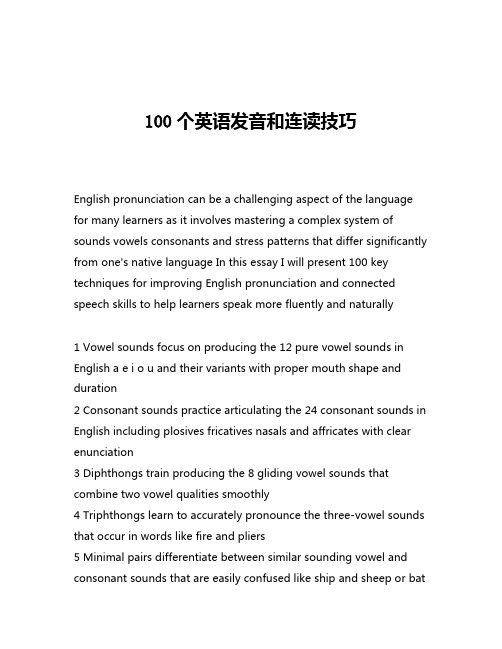
100个英语发音和连读技巧English pronunciation can be a challenging aspect of the language for many learners as it involves mastering a complex system of sounds vowels consonants and stress patterns that differ significantly from one's native language In this essay I will present 100 key techniques for improving English pronunciation and connected speech skills to help learners speak more fluently and naturally1 Vowel sounds focus on producing the 12 pure vowel sounds in English a e i o u and their variants with proper mouth shape and duration2 Consonant sounds practice articulating the 24 consonant sounds in English including plosives fricatives nasals and affricates with clear enunciation3 Diphthongs train producing the 8 gliding vowel sounds that combine two vowel qualities smoothly4 Triphthongs learn to accurately pronounce the three-vowel sounds that occur in words like fire and pliers5 Minimal pairs differentiate between similar sounding vowel and consonant sounds that are easily confused like ship and sheep or batand bed6 Tongue twisters develop agility and precision in articulating rapid sequences of sounds7 Stress and rhythm develop a sense of English's stressed-timed rhythm by practicing words phrases and sentences with proper syllable stress8 Intonation practice rising and falling pitch to convey meaning mood and attitude through intonation patterns9 Reductions and contractions learn to pronounce the shortened and blended forms of words and phrases that are common in natural speech10 Linking connect words smoothly by pronouncing final and initial consonant sounds together11 Assimilation adapt the pronunciation of sounds to blend more naturally with surrounding sounds12 Elision omit sounds that are difficult to pronounce in rapid speech13 Intrusion insert extra sounds between words for a smoother flow14 Liaison join words beginning with vowels to preceding words15 Palatalization modify a consonant sound before a following palatal consonant16 Nasalization nasalize vowel sounds before nasal consonants17 Flapping replace intervocalic t and d sounds with a flap18 Voicing and devoicing adjust the vibration of the vocal cords for certain consonant sounds19 Epenthesis insert an extra sound within a word20 Deletion remove sounds that are difficult to pronounce in connected speech21 Weak forms use reduced unstressed versions of common function words22 Thought groups divide sentences into meaningful chunks23 Pause placement insert pauses strategically for emphasis and clarity24 Prominence emphasize key words and ideas through stress and volume25 Rhythm and timing develop a natural sense of English's stress-timed rhythm26 Schwa production master the most common reduced vowel sound in unstressed syllables27 Consonant clusters simplify sequences of consonants28 Monophthongization avoid diphthongizing pure vowel sounds29 Syllabification divide words into their component syllables30 Blending smoothly connect sounds across word boundaries31 Elision of t and d in consonant clusters like "just go" and "old dog"32 Assimilation of place of articulation like "green bus" and "ten pandas"33 Voicing assimilation of final consonants like "big dog" and "bakedbeans"34 Liaison between vowel and consonant sounds across word boundaries35 Intrusion of a y or w sound between two vowels like "see you" and "the new one"36 Reduction of "to" in infinitive phrases like "going to" and "have to"37 Contraction of auxiliary verbs like "I'm" "you'll" and "they've"38 Weak forms of common function words like "a" "the" "and" and "of"39 Elision of intervocalic t and d sounds like "water" and "needed"40 Flapping of intervocalic t and d sounds like "better" and "ladder"41 Linking r to connect words ending and beginning with vowels42 Palatalization of t and d before y sounds like "tune" and "dew"43 Nasalization of vowels before nasal consonants like "song" and "running"44 Aspiration of voiceless plosives at the beginning of stressed syllables45 Glottalization of t sounds especially before a stressed syllable46 Reduction of "have" to "ve" in perfect constructions like "I've been"47 Deletion of "not" in negative contractions like "can't" and "won't"48 Assimilation of place or manner in consonant clusters like "ask you" and "next door"49 Intrusion of a y or w sound between a vowel and a following vowel50 Linking of final consonants to initial vowels across word boundaries51 Weak pronunciation of unstressed function words like "the" "a" "to" and "of"52 Reduction of "going to" to "gonna" and "want to" to "wanna"53 Assimilation of place or voicing in consonant clusters like "icks you" and "big shoes"54 Elision of final t and d sounds especially after certain consonants55 Flapping of intervocalic t and d sounds in words like "water" and "ladder"56 Linking of final consonants to initial vowels across word boundaries57 Palatalization of t and d before y sounds in words like "tune" and "dew"58 Nasalization of vowels before nasal consonants in words like "song" and "running"59 Glottalization of t sounds especially before a stressed syllable60 Deletion of "not" in negative contractions like "can't" and "won't"61 Weak forms of auxiliary verbs like "will" "would" "should" and "could"62 Intrusion of a y or w sound between a vowel and a followingvowel63 Assimilation of place or manner in consonant clusters like "ask you" and "next door"64 Deletion of final g in -ing word endings like "walking" and "running"65 Flapping of intervocalic t and d sounds in words like "water" and "ladder"66 Linking of final consonants to initial vowels across word boundaries67 Palatalization of s and z before y sounds in words like "onion" and "vision"68 Nasalization of vowels before nasal consonants in words like "song" and "running"69 Glottalization of t sounds especially before a stressed syllable70 Reduction of "going to" to "gonna" and "want to" to "wanna"71 Weak pronunciation of "a" as "uh" and "the" as "thuh"72 Elision of final t and d sounds especially after certain consonants73 Assimilation of place or voicing in consonant clusters like "icks you" and "big shoes"74 Linking of final consonants to initial vowels across word boundaries75 Palatalization of t and d before y sounds in words like "tune" and "dew"76 Nasalization of vowels before nasal consonants in words like"song" and "running"77 Glottalization of t sounds especially before a stressed syllable78 Deletion of "not" in negative contractions like "can't" and "won't"79 Flapping of intervocalic t and d sounds in words like "water" and "ladder"80 Weak forms of auxiliary verbs like "will" "would" "should" and "could"81 Intrusion of a y or w sound between a vowel and a following vowel82 Assimilation of place or manner in consonant clusters like "ask you" and "next door"83 Deletion of final g in -ing word endings like "walking" and "running"84 Linking of final consonants to initial vowels across word boundaries85 Palatalization of s and z before y sounds in words like "onion" and "vision"86 Nasalization of vowels before nasal consonants in words like "song" and "running"87 Glottalization of t sounds especially before a stressed syllable88 Reduction of "going to" to "gonna" and "want to" to "wanna"89 Weak pronunciation of "a" as "uh" and "the" as "thuh"90 Elision of final t and d sounds especially after certain consonants91 Assimilation of place or voicing in consonant clusters like "icks you" and "big shoes"92 Linking of final consonants to initial vowels across word boundaries93 Palatalization of t and d before y sounds in words like "tune" and "dew"94 Nasalization of vowels before nasal consonants in words like "song" and "running"95 Glottalization of t sounds especially before a stressed syllable96 Deletion of "not" in negative contractions like "can't" and "won't"97 Flapping of intervocalic t and d sounds in words like "water" and "ladder"98 Weak forms of auxiliary verbs like "will" "would" "should" and "could"99 Intrusion of a y or w sound between a vowel and a following vowel100 Assimilation of place or manner in consonant clusters like "ask you" and "next door"This essay covers 100 key techniques for improving English pronunciation and connected speech skills across a wide range of phonological processes including vowel and consonant production diphthongs and triphthongs stress and rhythm intonation reductions and contractions and various forms of assimilation elision intrusionand linking By practicing these techniques learners can develop more natural sounding and fluent English pronunciation。
48个国际音标记忆口诀

48个国际音标记忆口诀音标四十八,个个要记清。
元音单双二十个,辅音二八分分明。
单元音又分长短,长五短七就是行。
双元音集中八个整,两两组合要记清。
辅音清浊十对整,清是清来浊是浊。
剩下八个单个音。
一. 单元音[i:]、[ɔ:]、[ɔ]、[u:]、[ə:]、[ə]、[ɑ:]、[ʌ]、[e]、[æ]二. 双元音[ei]、[ai]、[ɔi]、[iə]、[ɛə]、[uə]、[au]、[əu]英语音标表发音规律记忆口诀:1.单元音:[i:]、[ɔ:]、[ɔ]、[u:]、[ə:]、[ə]、[ɑ:]、[ʌ]、[e]、[æ][i:]谐音为:易(yi);阿拉伯数字1,记住真容易。
像数字1,记忆真容易。
[ɔ:]谐音为:噢(0);哦,这个音标就像o。
[u:]谐音为:雾(wu);山上今天起了雾。
杯子上有很多雾。
[ə:]谐音为:饿(e);我饿得晕倒。
鹅倒立着行走就容易饿。
[ɑ:]谐音为:啊(a);音标的读音跟拼音一样。
[e]谐音为:夜(ye);马上就半夜。
我要灭了这只鹅。
2.双元音:[ei]、[ai]、[ɔi]、[iə]、[ɛə]、[uə]、[au]、[əu] [ei]谐音为:妹(mei);她是我妹妹。
鹅有一个妹妹。
[ai]谐音为:爱(ai);发音同拼音。
[ɔi]这个音标的发音我们可以想象成拼音o、i的连读。
[iə]谐音为:数字1、2的连读。
[ɛə]谐音为:挨饿;不吃饭就要挨饿。
外形像3只鹅,三只鹅都在挨饿。
[uə]谐音为:屋鹅;鸡鸭鹅都装在笼子里。
一屋子的鹅都装在杯子里。
[au]谐音为:傲(ao),骄傲使人进步。
一个杯子很骄傲,不让人拿它喝水。
[əu]谐音为:鸥(ou)海里有海鸥。
只鹅在杯子里找海鸥。
三、辅音[θ]、[ð]、[ʃ]、[ʒ](注:多数辅音的读音与拼音差别不大,可以通过拼音来进行谐音;还有一部分辅音没有对应的拼音字体,我们的记忆方法主要是针对这四个辅音。
)其中,[θ]和[ð]这两个音标,它们没有近似的拼音来对应,主要靠嘴形来记忆。
汉语拼音发音口诀及方法
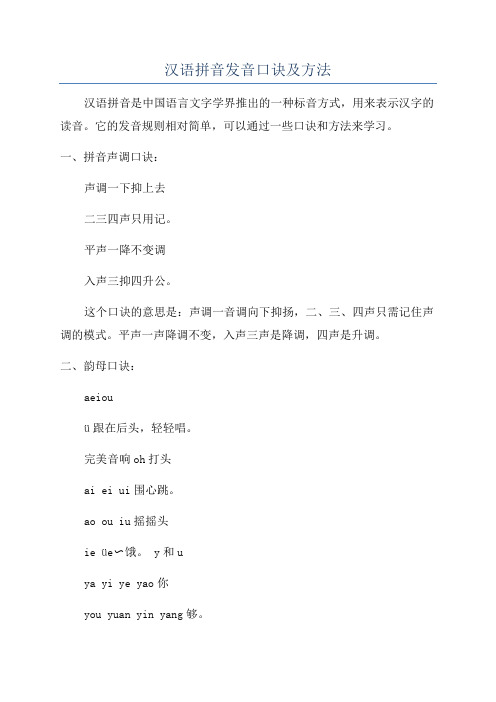
汉语拼音发音口诀及方法汉语拼音是中国语言文字学界推出的一种标音方式,用来表示汉字的读音。
它的发音规则相对简单,可以通过一些口诀和方法来学习。
一、拼音声调口诀:声调一下抑上去二三四声只用记。
平声一降不变调入声三抑四升公。
这个口诀的意思是:声调一音调向下抑扬,二、三、四声只需记住声调的模式。
平声一声降调不变,入声三声是降调,四声是升调。
二、韵母口诀:aeiouü跟在后头,轻轻唱。
完美音响oh打头ai ei ui围心跳。
ao ou iu摇摇头ie üe〜饿。
y和uya yi ye yao你you yuan yin yang够。
这个口诀是用来记忆韵母的发音。
a、e、i、o、u的发音是相对固定的,ü要跟在后头并轻轻唱。
ai、ei、ui的发音相对特殊,类似于围心跳的声音。
ao、ou、iu的发音是类似于摇头的声音。
ie、üe发音类似于饿的声音。
y和u的发音则需要根据前面的声母来决定。
三、声母口诀:bpmfdtnlg k hb是靠。
jqx双子模zh ch sh是兄弟rzcs给力耶yw只发音。
这个口诀的意思是:b p m f、d t n l、g k h是以b为基础的,jq x是以j为基础的,zh ch sh是以zh为基础的。
r z c s只有在其他字母的前面才发音,y w只有在韵母前面才发音。
四、拼音方法:1.学习声母时,可以通过了解声母的发音特点来记忆,比如b、p、m、f都是双唇音,d、t、n、l都是舌尖音,g、k、h都是取杀音。
2.学习韵母时,可以通过和母语拼音的发音进行对照记忆。
3.声调的记忆可以通过一些练习来熟悉,比如多听标准的发音,并跟随发音进行模仿。
4.在学习拼音时要多加练习,可以通过朗读和听力练习来提高口语。
5.在学习拼音时,可以通过使用拼音输入法来提高打字速度和准确性。
总结:学习汉语拼音需要多练习和重复记忆。
掌握拼音的口诀和发音方法可以帮助学习者更快地掌握拼音知识。
英语发音48个音标趣味记忆法

英语发音48个音标趣味记忆法一、元音(20个)1. 长元音(5个)- /ɑ:/:想象一个张大嘴巴的“啊”,像看到医生拿着大针筒要打针时发出的惊恐的“啊”,可以联想“car(汽车)”,汽车喇叭发出长长的“啊”声。
- /ɔ:/:这个音可以想象成模仿老虎叫“嗷”,但是要拖长音。
比如“dog (狗)”中的“o”音,狗叫的时候有点像拖长的“嗷”。
- /ɜ:/:可以想象是在做惊讶表情时发出的声音,嘴巴向两边咧开。
比如“bird (鸟)”,鸟在枝头唱歌,声音悠长,发这个音。
- /u:/:就像看到了超级美味的食物,发出长长的“呜”声。
像“blue(蓝色)”,想象一片蓝色的大海,对着大海发出长长的“呜”。
- /əʊ/:由/əʊ/两个音组成,可以联想成一只小鹅“鹅(ə)”突然看到了一个大球“欧(ʊ)”,很惊喜的感觉。
像“go(去)”这个单词就发这个音。
2. 短元音(7个)- /ʌ/:嘴巴微微张开,短促地发出“啊”,可以想象是被人轻轻掐了一下时发出的声音。
比如“bus(公共汽车)”。
- /ɒ/:短促的“嗷”,像小猫生气时发出的声音。
例如“box(盒子)”。
- /əʊ/:可以想象是一个小木偶突然动了一下发出的声音。
比如“book (书)”。
- /u/:嘴巴收成圆形,短促地发“呜”,像吹蜡烛时轻轻吹的声音。
像“good (好的)”。
- /e/:嘴巴向两边咧开,短促地发“唉”,就像看到有点意外的小事情时的反应。
例如“pen(钢笔)”。
- /æ/:嘴巴张得大大的,短促地发“唉”,比/e/的口型更大,像看到很惊讶的事情。
像“cat(猫)”。
- /əʊ/:可以想象是小老鼠“吱(ə)”的一声,然后迅速跑开“欧(ʊ)”。
比如“cup(杯子)”。
3. 双元音(8个)- /eɪ/:可以联想成字母A的发音,由/e/滑向/ɪ/,像在说“day(天)”,就像从有点惊讶“唉(e)”到轻松的“一(ɪ)”的感觉。
- /aɪ/:由/a/滑向/ɪ/,可以想象是看到了很厉害的东西,先发出大大的“啊”,然后变成轻声的“一”。
100个发音秘决文本(打印版)
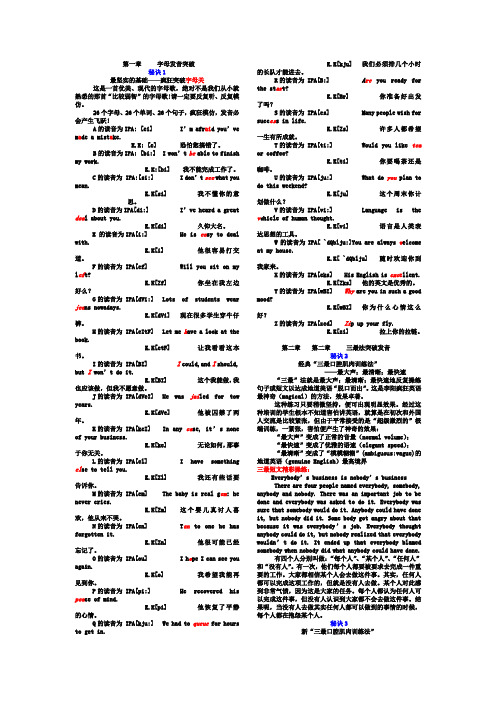
第一章字母发音突破秘诀1最坚实的基础——疯狂突破字母关这是一首优美、现代的字母歌,绝对不是我们从小就熟悉的那首“比较弱智”的字母歌!请一定要反复听、反复模仿。
26个字母、26个单词、26个句子,疯狂模仿,发音必会产生飞跃!A的读音为IPA: [ei] I’m afr ai d you’ve m a de a mist a ke.K.K: [e] 恐怕您搞错了。
B的读音为IPA: [bi:] I won’t be able to finish my work.K.K:[bi] 我不能完成工作了。
C的读音为 IPA:[si:] I don’t see what you mean.K.K[si] 我不懂你的意思。
D的读音为IPA[di:] I’ve heard a great dea l about you.K.K[di] 久仰大名。
E 的读音为IPA[i:] He is ea sy to deal with.K.K[i] 他很容易打交道。
F的读音为 IPA[ef] Will you sit on my l ef t?K.K[Zf] 你坐在我左边好么?G的读音为 IPA[dVi:] Lots of students wear jea ns nowadays.K.K[dVi] 现在很多学生穿牛仔裤。
H的读音为 IPA[eItF] Let me h ave a look at the book.K.K[etF] 让我看看这本书。
I的读音为 IPA[BI] I could,and I should, but I won’t do it.K.K[BI] 这个我能做,我也应该做,但我不愿意做。
J的读音为 IPA[dVeI] He was jai led for tow years.K.K[dVe] 他被囚禁了两年。
K的读音为 IPA[keI] In any ca se, it’s none of your business.K.K[ke] 无论如何,那事于你无关。
李阳100个发音秘决后几章

她在医院
里当护士。
The early bird gets the worm.
捷足先登。
The girl was murdered three days ago. 三天前这
个女孩子被人杀害了。
秘诀87
口形解说:
中元音[L]、[E]的发音技巧
舌端离下齿,舌身平展而放松;牙床稍半开;
英国[E]和汉语普通话里的轻声字“么”,“了”中的元音“e”极为相似。 美国中元音[L]是由[E]+卷舌符号“ _ 所构成;叫轻读卷舌音。
我希望一切顺利。
不
达目的,决不罢休。
I wish for an opportunity to go
abroad.
我希望有机会出国。
The doctor’s daughter knocked at the locked
door.
医生的女儿敲了上了锁的门。
秘诀90 后元音[C]的发音技巧
口形解说: 舌身伸平后缩,舌后部抬得比[B]略高; 双唇收得比[B]更圆更小;而且向外突出。
发音时北京话中的“花儿”的“儿”音。这个卷舌产生的“儿”或“r”音就用加 在[\]右上角的“_ 来表示,这样就构成了[\_],这样独特的一个音
标,这是美式元音的特色之一。
疯狂简说:
在李阳疯狂英语中叫做“拉长、重读卷舌”音。
疯狂操练:
She works as a nurse in a hospital.
I left very early last night. 我昨天晚上离开得很糟。
I shall never forget the lesson. 我决不会忘记这个教
训。
口形解说:
秘诀82 长元音[A]的发音技巧
汉语拼音音标口诀
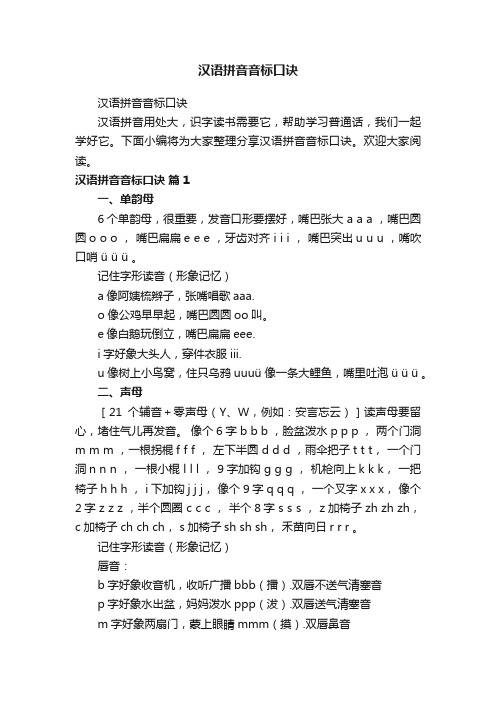
汉语拼音音标口诀汉语拼音音标口诀汉语拼音用处大,识字读书需要它,帮助学习普通话,我们一起学好它。
下面小编将为大家整理分享汉语拼音音标口诀。
欢迎大家阅读。
汉语拼音音标口诀篇1一、单韵母6个单韵母,很重要,发音口形要摆好,嘴巴张大 a a a ,嘴巴圆圆o o o ,嘴巴扁扁e e e ,牙齿对齐 i i i ,嘴巴突出u u u ,嘴吹口哨ü ü ü 。
记住字形读音(形象记忆)a像阿姨梳辫子,张嘴唱歌aaa.o像公鸡早早起,嘴巴圆圆oo叫。
e像白鹅玩倒立,嘴巴扁扁eee.i字好象大头人,穿件衣服iii.u像树上小鸟窝,住只乌鸦uuuü像一条大鲤鱼,嘴里吐泡ü ü ü 。
二、声母[21个辅音+零声母(Y、W,例如:安言忘云)]读声母要留心,堵住气儿再发音。
像个6字 b b b ,脸盆泼水p p p ,两个门洞m m m ,一根拐棍f f f ,左下半圆 d d d ,雨伞把子t t t,一个门洞n n n ,一根小棍 l l l , 9字加钩 g g g ,机枪向上k k k,一把椅子h h h , i下加钩j j j,像个9字q q q ,一个叉字 x x x,像个2字 z z z ,半个圆圈 c c c ,半个8字 s s s , z加椅子 zh zh zh,c加椅子 ch ch ch, s加椅子sh sh sh,禾苗向日r r r 。
记住字形读音(形象记忆)唇音:b字好象收音机,收听广播bbb(播).双唇不送气清塞音p字好象水出盆,妈妈泼水ppp(沷).双唇送气清塞音m字好象两扇门,蒙上眼睛mmm(摸).双唇鼻音f像一根小拐棍,爷爷靠它fff(扶). 齿唇清察音舌尖音:(舌尖中音,也叫舌翘音)d字好象小马蹄,跑起路来ddd.(得)舌尖中不送气清塞音t像一把小雨伞,下雨打开ttt.(它)舌尖中送气清塞音n像火车进隧道,赶快鸣笛nnn.(呢)舌尖中鼻音l像一根大木棍,打跑老狼lll.(乐)舌尖中边音舌根音(也叫舌面后音):g像9和弯镰刀,收割庄稼ggg.(割)舌面后不送气清塞音k像大锤和凿子,雕刻石头kkk.(刻)舌面后送气清塞音h像倒立小酒杯,装满美酒hhh.(喝)舌面后清擦音舌面前音:j像一只小公鸡,圆圆眼睛jjj.(鸡)舌面前不送气清塞擦音q像一面小红旗,迎风飘扬qqq.(旗)舌面前送气清塞擦音x像西瓜切四半,娃娃吃瓜笑xxx.(嘻)舌面前清擦音平舌音:(舌尖前音)z像一个数字2,娃娃写字乐zzz.(滋)舌尖前不送气清塞擦音c像一只小刺猬,弯起身体ccc.(刺)舌尖前送气清塞擦音s像树上蚕宝宝,吐丝织茧sss.(丝)舌尖前清擦音r像田里小禾苗,向着太阳rrr.(日)舌尖前浊擦音舌尖后音:(也叫翘舌音)zcs小酒鬼,见到酒杯(h)舌头翘,说话变成zh(蜘)ch(吃)sh(狮)。
普通话发声训练方法
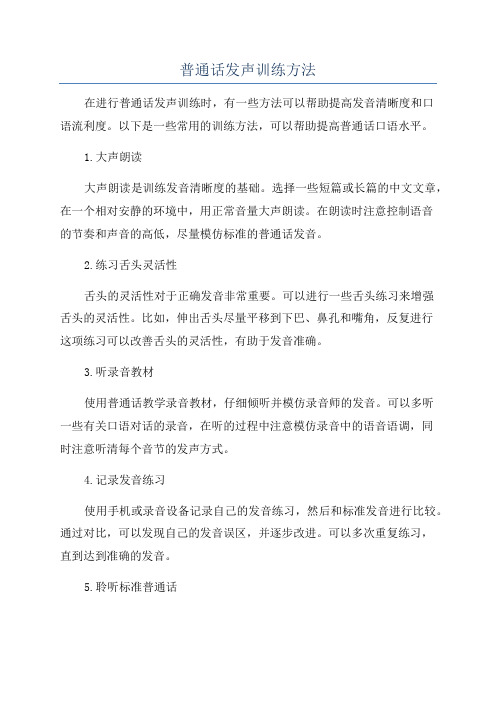
普通话发声训练方法在进行普通话发声训练时,有一些方法可以帮助提高发音清晰度和口语流利度。
以下是一些常用的训练方法,可以帮助提高普通话口语水平。
1.大声朗读大声朗读是训练发音清晰度的基础。
选择一些短篇或长篇的中文文章,在一个相对安静的环境中,用正常音量大声朗读。
在朗读时注意控制语音的节奏和声音的高低,尽量模仿标准的普通话发音。
2.练习舌头灵活性舌头的灵活性对于正确发音非常重要。
可以进行一些舌头练习来增强舌头的灵活性。
比如,伸出舌头尽量平移到下巴、鼻孔和嘴角,反复进行这项练习可以改善舌头的灵活性,有助于发音准确。
3.听录音教材使用普通话教学录音教材,仔细倾听并模仿录音师的发音。
可以多听一些有关口语对话的录音,在听的过程中注意模仿录音中的语音语调,同时注意听清每个音节的发声方式。
4.记录发音练习使用手机或录音设备记录自己的发音练习,然后和标准发音进行比较。
通过对比,可以发现自己的发音误区,并逐步改进。
可以多次重复练习,直到达到准确的发音。
5.聆听标准普通话聆听标准的普通话是提高口语的关键。
可以通过收听电视、广播或者听普通话教材来提升听力水平,学习标准的语音语调。
也可以找一些普通话主持人的节目,模仿他们的发音和语调。
6.口型练习练习正确的口型可以帮助改善发音。
可以用镜子作为辅助工具,观察自己的口型和嘴巴的形状。
通过对比标准的口型,调整自己的口音发音方式。
7.参加普通话角色扮演通过参加普通话角色扮演活动,模仿标准的普通话。
可以扮演不同的角色,练习发音和语调。
这样的活动可以增加对话的真实感,提高口语表达能力。
8.阅读大量中文文章阅读是提高普通话口语的有效方式之一、阅读大量的中文文章,可以帮助增加词汇量、改善语感,并提高口语流利度。
可以选择曲目多样的文章,涵盖不同的主题,有助于提高对不同领域的理解和表达能力。
9.参加普通话口语团体讨论参加普通话口语团体讨论活动,与其他人一起练习普通话对话。
可以以小组形式讨论话题,并尽量用普通话进行交流。
汉语拼音发音技巧
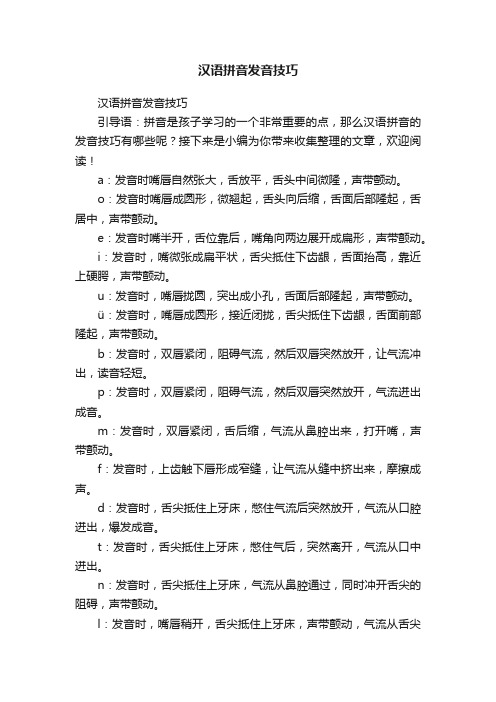
汉语拼音发音技巧汉语拼音发音技巧引导语:拼音是孩子学习的一个非常重要的点,那么汉语拼音的发音技巧有哪些呢?接下来是小编为你带来收集整理的文章,欢迎阅读!a:发音时嘴唇自然张大,舌放平,舌头中间微隆,声带颤动。
o:发音时嘴唇成圆形,微翘起,舌头向后缩,舌面后部隆起,舌居中,声带颤动。
e:发音时嘴半开,舌位靠后,嘴角向两边展开成扁形,声带颤动。
i:发音时,嘴微张成扁平状,舌尖抵住下齿龈,舌面抬高,靠近上硬腭,声带颤动。
u:发音时,嘴唇拢圆,突出成小孔,舌面后部隆起,声带颤动。
ü:发音时,嘴唇成圆形,接近闭拢,舌尖抵住下齿龈,舌面前部隆起,声带颤动。
b:发音时,双唇紧闭,阻碍气流,然后双唇突然放开,让气流冲出,读音轻短。
p:发音时,双唇紧闭,阻碍气流,然后双唇突然放开,气流迸出成音。
m:发音时,双唇紧闭,舌后缩,气流从鼻腔出来,打开嘴,声带颤动。
f:发音时,上齿触下唇形成窄缝,让气流从缝中挤出来,摩擦成声。
d:发音时,舌尖抵住上牙床,憋住气流后突然放开,气流从口腔迸出,爆发成音。
t:发音时,舌尖抵住上牙床,憋住气后,突然离开,气流从口中迸出。
n:发音时,舌尖抵住上牙床,气流从鼻腔通过,同时冲开舌尖的阻碍,声带颤动。
l:发音时,嘴唇稍开,舌尖抵住上牙床,声带颤动,气流从舌尖两边流出。
g:发音时,舌根前部抵住软腭阻碍气流,让气流冲破舌根的阻碍,爆发成音。
k:发音时,舌根前部,抵住上软腭,阻碍气流,让气流冲破舌根的阻碍,迸发成音。
h:发音时,舌根抬高,接近软腭,形成窄缝,气流从缝中挤出,摩擦成音。
j:发音时,舌尖抵住下门齿,舌面前部紧贴硬腭,气流从窄缝中冲出,摩擦成音。
q:发音时,舌面前部贴住硬腭,气流冲破舌根的阻碍,摩擦成音。
x:发音时,舌尖抵住下门齿,舌面前部抬高靠近硬腭,形成窄缝,气流从缝中挤出,摩擦成音。
zh:发音时,舌尖上翘,抵住硬腭前部,有较弱的气流冲开舌尖阻碍,从缝中挤出,摩擦成音。
- 1、下载文档前请自行甄别文档内容的完整性,平台不提供额外的编辑、内容补充、找答案等附加服务。
- 2、"仅部分预览"的文档,不可在线预览部分如存在完整性等问题,可反馈申请退款(可完整预览的文档不适用该条件!)。
- 3、如文档侵犯您的权益,请联系客服反馈,我们会尽快为您处理(人工客服工作时间:9:00-18:30)。
100个发音秘诀第一章\第一章字母发音突破秘诀1最坚实的基础——疯狂突破字母关这是一首优美、现代的字母歌,绝对不是我们从小就熟悉的那首“比较弱智”的字母歌!请一定要反复听、反复模仿。
26个字母、26个单词、26个句子,疯狂模仿,发音必会产生飞跃!A的读音为IPA: [♏♓]I’m afr ai d you’ve m a de a mist a ke.K.K: [♏]恐怕您搞错了。
B的读音为IPA: [♌♓]I won’t be able to finish my work.K.K:[♌♓]我不能完成工作了。
C的读音为 IPA:[♦♓]I don’t see what you mean.K.K[♦♓]我不懂你的意思。
D的读音为IPA[♎♓] I’ve heard a great dea l about you.K.K[♎♓]久仰大名。
E的读音为IPA[♓] He is ea sy to deal with.K.K[♓]他很容易打交道。
F的读音为 IPA[♏♐] Will you sit on my l ef t?K.K[☪♐] 你坐在我左边好么?G的读音为 IPA[♎✞♓]Lots of students wear jea ns nowadays.K.K[♎✞♓]现在很多学生穿牛仔裤。
H的读音为 IPA[♏✋♦☞]Let me h ave a look at the book.K.K[♏♦☞] 让我看看这本书。
I的读音为 IPA[ ✋] I could,and I should, but I won’t do it.K.K[ ✋] 这个我能做,我也应该做,但我不愿意做。
J的读音为 IPA[♎✞♏✋]He was jai led for tow years.K.K[♎✞♏] 他被囚禁了两年。
K的读音为 IPA[ ♏✋]In any ca se, it’s none of your business.K.K[ ♏] 无论如何,那事于你无关。
L的读音为 IPA[♏●]I have something el se to tell you.K.K[☪●]我还有些话要告诉你。
M的读音为 IPA[♏❍]The baby is real g em; he never cries.K.K[☪❍]这个婴儿真讨人喜欢,他从来不哭。
N的读音为 IPA[♏⏹]T en to one he has forgotten it.K.K[☪⏹]他很可能已经忘记了。
O的读音为 IPA[☐◆]I h o pe I can see you again.K.K[☐]我希望我能再见到你。
P的读音为 IPA[☐♓]He recovered his pea ce of mind.K.K[☐♓]他恢复了平静的心情。
Q的读音为 IPA[ ◆] We had to queue for hours to get in.K.K[ ◆]我们必须排几个小时的长队才能进去。
R的读音为 IPA[ ]A re you ready for the st ar t?K.K[ ❒]你准备好出发了吗?S的读音为 IPA[♏♦]Many people wish for succ es s in life.K.K[☪♦]许多人都希望一生有所成就。
T的读音为 IPA[♦♓]Would you like tea or coffee?K.K[♦♓]你要喝茶还是咖啡。
U的读音为 IPA[ ◆]What do you plan to do this weekend?K.K[ ◆]这个周末你计划做什么?V的读音为 IPA[❖♓]Language is the v e hicle of human thought.K.K[❖♓]语言是人类表达思想的工具。
W的读音为IPA[ ♊♎✈♌●◆]You are always w elcome at my house.K.K[ ♊♎✈♌●◆]随时欢迎你到我家来。
X的读音为 IPA[♏♦]His English is exc e llent.K.K[☪♦]他的英文是优秀的。
Y的读音为 IPA[♦✋]Why are you in such a good mood?K.K[♦✋]你为什么心情这么好?Z的读音为 IPA[ ♏♎]Zi p up your fly.K.K[ ♓]拉上你的拉链。
第二章第二章三最法突破发音秘诀2经典“三最口腔肌肉训练法”——最大声;最清晰;最快速“三最”法就是最大声;最清晰;最快速地反复操练句子或短文以达成地道美语“脱口而出”。
这是李阳疯狂英语最神奇(magical)的方法,效果卓著。
这种练习只要稍微坚持,便可出现明显效果。
经过这种培训的学生根本不知道害怕讲英语,就算是在初次和外国人交流是比较紧张,但由于平常接受的是“超级激烈的”极端训练,一紧张,害怕便产生了神奇的效果:“最大声”变成了正常的音量(normal volume);“最快速”变成了优雅的语速(elegant speed);“最清晰”变成了“模模糊糊”(ambiguous;vague)的地道英语(genuine English)最高境界三最短文精彩操练:Everybody’s business is nobody’s businessThere are four people named everybody, somebody, anybody and nobody. There was an important job to be done and everybody was asked to do it. Everybody was sure that somebody would do it. Anybody could have done it, but nobody did it. Some body got angry about that because it was everybody’s job. Everybody thought anybody could do it, but nobody realized that everybody wouldn’t do it. It ended up that everybody blamed somebody when nobody did what anybody could have done.有四个人分别叫做:“每个人”、“某个人”、“任何人”和“没有人”。
有一次,他们每个人都要被要求去完成一件重要的工作。
大家都相信某个人会去做这件事。
其实,任何人都可以完成这项工作的,但就是没有人去做。
某个人对此感到非常气愤,因为这是大家的任务。
每个人都认为任何人可以完成这件事,但没有人认识到大家都不会去做这件事。
结果呢,当没有人去做其实任何人都可以做到的事情的时候,每个人都在抱怨某个人。
秘诀3新“三最口腔肌肉训练法”——最夸张、最慢速、最频繁经典范例:SpringtimeDays get longer and warmer in the spring.There are new leaves on the trees.Flowers begin to grow.Rain makes the grass green and helps the plants grow.Spring is the time of new life. Nature puts on new clothes in manycolors —red, yellow, blue, white, and purple.Birds build nests in the spring.Many baby animals appear.People like to make gardens and farmers plant crops in the fields.Spring is the season for young love. “In the spring a young man’sthoughts turn to love.” according to an old saying.第三章一口气突破发音秘诀4一口气训练法当美国人讲话的时候底气很足,令人羡慕!为什么呢?因为他们讲话时用的是腹腔、胸腔、喉腔、口腔、鼻腔“合五为一”所以底气十足。
我们中国人讲话使用的是嘴巴,没有底气,说话时发音不饱满,力量不足。
所以我们中国人要想说一口地到流利的英文,必须在“五大发音秘诀”和“三最口腔肌肉训练法”之后,再用“一口气训练法”疯狂操练。
做法很简单:你只要深呼吸,然后再一口气里尽量多读。
经过一段时间的训练以后,原来需要换几次气才能读完的一句话或小短文,一口气里就能轻松读完!经典范例:A: Hi Stone! How have you been?B: Great! What about you?A: Sorry, I’m so late getting back to the office. How’s everything.B: Oh, I’ve been super.A: Hey, could I borrow your car for the weekend?B: Go to hell! The last time you borrowed my car you wrecked it.秘诀5调动腹部的力量中国人习惯用嘴巴说话,显得比较“单薄”,有气无力;美国人习惯用腹部的力量说话,浑厚有力。
这就是中国人说英语和英美人说英语的最大区别。
疯狂做法:平时练习英语时,尽量运动腹部的肌肉,刚开始有点别扭,坚持一下,便会产生效果。
中国人开口说英语就能听出是中国口音。
请听下面的录音。
How are you doing?A: How are you doing, Lee?B: I beg your pardon?A: How ‘s everything? How are you getting along?B: I’m getting along fine, thank you.A: Have you changed any of your ideas about this country? Do you still think English is the worst language in the world?B: I’m beginning to see that human nature is pretty much thesame everywhere.A: And what about the language?B: That idea hasn’t changed.第四章元、辅音发音操练秘诀6悦耳动听在元音英语是否好听,主要取决于援引是否饱满、到位!请听下面的录音。
